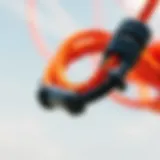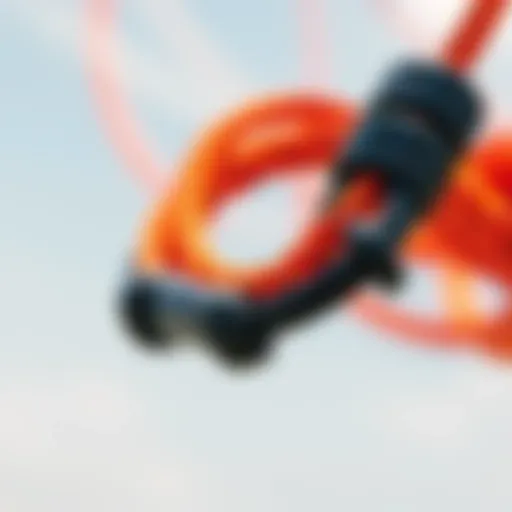The Electric Hydro Board: Transforming Kiteboarding Today


Intro
The world of water sports has continuously evolved, driven by technology and innovation. Among the remarkable advancements lies the electric hydro board—a game-changer specifically tailored for kiteboarding enthusiasts. This cutting-edge equipment blends the thrill of traditional kiteboarding with the effortless glide of electric propulsion, allowing riders to experience the waters in an entirely new way.
As the popularity of kiteboarding surges, the electric hydro board offers an array of features that elevate the sport, bringing along a mix of exhilaration and convenience. This article will not only dig into the design and functionality of these boards but also explore their benefits and challenges. Here, readers will find insights tailored for gear-junkies and thriving kiteboarders alike, focusing on essential gear and techniques to maximize the kiteboarding experience.
Stay tuned as we journey through the waters of innovation in kiteboarding and the electric hydro board's indispensable role in this evolution.
Gear and Equipment
When it comes to kiteboarding, having the right gear is crucial, particularly for integrating electric hydro boards into your experience. The following sections detail both essential gear for beginners and advanced equipment for experienced riders, focusing on what makes each piece important in creating a safe and enjoyable adventure on the water.
Essential Kiteboarding Gear for Beginners
For those just getting their feet wet in kiteboarding, certain gear stands out to ensure an enjoyable start:
- Kite: The heart of kiteboarding. Beginners should opt for a stable, easy-to-handle kite that allows for smooth rides. A common recommendation is a larger kite for light winds, typically around 12-15 square meters.
- Board: A basic twin-tip board is perfect for novices. It offers balance and ease of use while learning the ropes. Look for one with a soft flex to cushion landings.
- Harness: Comfort goes hand-in-hand with safety. Choose a seat or waist harness that fits properly and distributes load effectively across the body for improved control.
- Safety Leash: This is a critical piece of equipment that connects the rider to the kite. A reliable safety leash can prevent accidents in the unexpected moments.
- Life Jacket: Safety should always come first. An inflatable life jacket, especially one designed for water sports, can be a lifesaver in emergency situations.
Advanced Equipment for Experienced Riders
Once a rider has honed their skills, upgrading their equipment enhances performance:
- Electric Hydro Board: This is a true leap forward. The electric propulsion system allows users to glide effortlessly over water, enabling longer rides without the tug of a traditional kite. Riders can experience higher speeds and increased maneuverability, often equipped with remote controls for optimal control.
- High-Aspect Ratio Kites: These kites are designed for speed and efficiency. They allow experienced riders to ride with less power, gliding through various wind conditions seamlessly.
- Carbon Fiber Boards: For those who truly want to optimize their performance, a lightweight carbon fiber board not only enhances speed but also improves handling in rough waters.
- Wetsuit: As conditions change, having a high-quality wetsuit for different temperatures safeguards you from chill and allows for longer time on the water.
With the right gear, both beginners and seasoned pros can revel in their kiteboarding adventures, especially when integrating electric hydro boards into their arsenal.
"The right equipment makes all the difference. It takes the thrill of kiteboarding and sends it soaring to new heights."
As we segue into exploring techniques and tips vital for both safety and improvement, it's essential to remember that every kiteboarder faces unique challenges. Consider this gear as the foundation upon which skills are built—stay tuned for more insights and useful strategies that ensure your kiteboarding experiences are thrilling yet safe.
Prelude to Electric Hydro Boards
Electric hydro boards signify a pivotal change in the realm of water sports, particularly enhancing the experience of kiteboarding. By integrating sleek designs with cutting-edge technology, these boards offer a more efficient and exhilarating riding experience. Understanding electric hydro boards isn't merely about grasping a new sport; it's about recognizing how such innovations reshape our approach to outdoor recreation. This introductory section sheds light on what makes electric hydro boards essential in today's sports environment, mainly focusing on performance enhancements, eco-friendliness, and accessibility for a broader audience.
Defining Electric Hydro Boards
When we talk about electric hydro boards, we refer to surfboards equipped with electric motors that allow riders to glide effortlessly over water. These boards typically feature a hydrofoil, which is a wing-like structure underneath the board. This allows the board to rise above the surface, cutting through water while minimizing resistance. Riders can control their speed with a handheld remote, which also makes it engaging for both seasoned kiteboarders and newcomers alike.
The beauty of electric hydro boards lies in their versatility. Whether you're carving through the waves or gliding smoothly under the sun, the board's design caters to a variety of riding styles and conditions. These boards are often crafted from lightweight materials like carbon fiber or durable plastics, ensuring they can withstand the rigors of intense usage while remaining manageable for users.
Historical Context
The journey of electric hydro boards is rooted in the broader evolution of water sports. While traditional kiteboarding has been around since the 1990s, the introduction of electric technology in boarding sports has gradually gained traction over the past decade. Early prototypes were heavy and cumbersome, but they marked the first steps towards a now booming industry. With advancements in battery technology and propulsion systems, electric hydro boards have transformed from niche products into mainstream players in water sports.
The first electric hydro boards were often seen as experimental, catering primarily to enthusiasts with substantial financial resources. However, they have gradually become more accessible. Companies that specialize in water sports equipment have begun investing heavily in research and development, leading to improved and affordable options for the everyday consumer. Today, electric hydro boards are not only a testament to engineering prowess but also part of a growing trend towards sustainable outdoor activities. As the environmental impact of traditional sports becomes more pronounced, these electric boards offer a greener alternative for adventure seekers eager for thrills without guilt.
In summary, the foundation of electric hydro boards reflects the fusion of innovation with passion for water sports, creating opportunities for riders to push boundaries while enjoying the serene beauty of nature.
Technical Specifications of Electric Hydro Boards
Understanding the technical specifications of electric hydro boards is crucial not only for performance enhancement but also for ensuring safety and durability in diverse water conditions. These specifications encompass various elements that contribute to the overall functionality of hydro boards, from the materials used in their construction to the technology powering them.
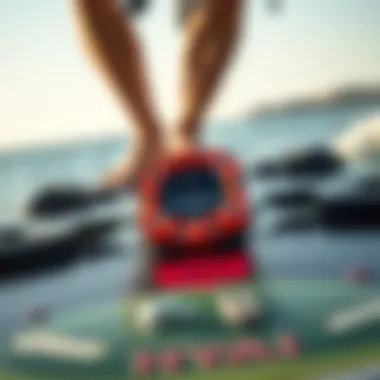
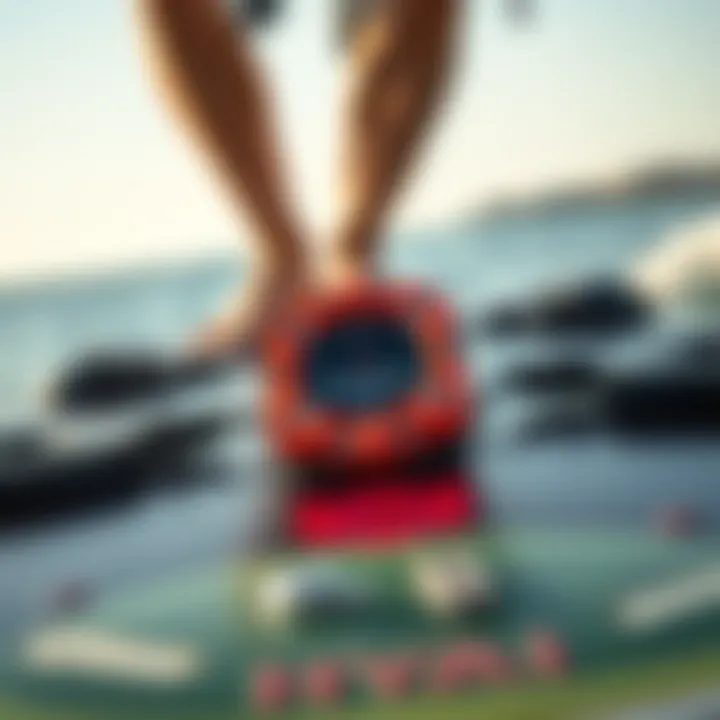
Components and Materials
Electric hydro boards, like any cutting-edge product in water sports, require materials that can withstand significant stress and environmental factors. Generally, manufacturers opt for composite materials, such as carbon fiber and fiberglass, for their lightweight and high-strength properties. Here’s a closer look:
- Carbon Fiber: Renowned for its rigidity and strength-to-weight ratio, carbon fiber boards can handle rough waters while remaining agile. It’s no wonder they are popular among serious kiteboarders seeking maximum performance.
- Fiberglass: Slightly heavier than carbon fiber but generally more affordable, fiberglass remains a viable option for those new to the sport.
- Foam Core: A robust foam core is often used as a foundation, providing buoyancy and stability to the board. It’s worth noting that the construction methods, such as hand-layup or vacuum infusion, can also affect the board’s overall performance and cost.
Electric hydro boards represent the cutting edge of material science and engineering within the world of kiteboarding. Choosing the right board that aligns with one’s skill level and style is essential.
Battery Technology
One of the most intriguing aspects of electric hydro boards is their battery technology, pushing the limits of what is possible in water sports. The longevity and efficiency of battery systems directly impact the ride experience. Here are some key points to understand:
- Lithium-Ion Batteries: Most modern electric hydro boards use advanced lithium-ion batteries, which provide a significant energy density allowing for longer rides without needing frequent recharges. They have a relatively low weight and high cycle life, making them ideal for water sports.
- Charging Time: Depending on the battery’s capacity, charging time can vary significantly. Many boards require approximately two to three hours for a full charge, which is manageable for most enthusiasts during breaks.
- Safety Features: It’s crucial for these batteries to include safety mechanisms to prevent overheating or failure, ensuring peace of mind while riding.
Investing in a hydro board with reliable battery technology is paramount, as it translates to a better experience on the water, where nothing is worse than losing power mid-ride.
Propulsion Systems
Lastly, the propulsion system is at the heart of electric hydro boards, driving their performance in the water. Understanding how these systems work will help riders to optimize their experience.
- Electric Motors: Most hydro boards come equipped with powerful brushless electric motors that are water-resistant, providing efficient power output with minimal maintenance required. Different motors might offer varied thrust, impacting acceleration and top speed.
- Remote Controls: Riders typically have the ability to control speed via handheld remote controls. This allows for the level of customization and control needed to navigate various conditions.
- Hydrofoils: Some advanced models incorporate hydrofoils for a smoother ride and enhanced efficiency. Foils lift the board above the water's surface, reducing drag and allowing for higher speeds with less power.
The integration of these components not only elevates the riding experience but also emphasizes a new level of technical sophistication in the realm of water sports.
Understanding the technical specifications of electric hydro boards is essential for optimizing performance and safety, especially in the diverse conditions encountered by kiteboarders.
By delving into components, battery choices, and propulsion systems, we uncover how each part plays a vital role in the exciting world of electric hydro sports. Enthusiasts looking to push their limits can significantly benefit from this understanding.
Advantages of Using Electric Hydro Boards
The rise of electric hydro boards is not just a passing trend but a pivotal shift in how we engage with water sports. They have reshaped the kiteboarding landscape, providing skimming enthusiasts with state-of-the-art options that enhance their experience. In this section, we will delve into the substantial benefits of using electric hydro boards, touching on performance, environmental sustainability, and accessibility.
Enhancing Performance
When discussing performance, electric hydro boards bring a new level of excitement and efficiency to kiteboarding. The unique propulsion systems integrated into these boards allow riders to glide effortlessly over the water, navigating waves with a newfound finesse. The blend of technology and craftsmanship offers immediate acceleration without the learning curve often associated with traditional kiteboarding.
- Smooth Ride: The electric motor contributes to a luxurious ride, reducing the choppy feel that can frustrate beginners and experts alike.
- Customized Speed Control: Advanced throttle systems enable riders to find their optimal speed. This customization allows for seamless maneuvering, making it easier to adapt to different water conditions.
- More Time on the Water: With the help of powerful batteries, a rider can enjoy extended sessions without the physical strain associated with paddleboarding or long-distance kiteboarding. Less fatigue means more fun.
"Electric hydro boards can redefine how we experience water sports, making it accessible and exhilarating!"
Environmental Impact
As we ride the waves, it's essential to consider our role in preserving the planet. Electric hydro boards are leading the charge towards greener water sports. Many boards employ more eco-friendly battery technology, significantly minimizing their carbon footprint compared to traditional fuel-powered vessels.
- Reduced Noise Pollution: Unlike gas-powered boats, electric hydro boards operate quietly. This allows riders to enjoy nature without disrupting marine life.
- Sustainable Materials: Many manufacturers are committed to using sustainable materials in the construction of electric hydro boards, contributing to a more eco-conscious water sports industry.
- Conservation Consciousness: Electric hydro boards open up new discussions around environmental protection, inspiring users to become advocates for ocean conservation, water cleanliness, and reducing plastic waste.
User Accessibility
Electric hydro boards are not just for seasoned pros; they offer ample benefits for beginners, making them a versatile choice for various skill levels. This makes kiteboarding a more inviting sport for newcomers and creates opportunities for growth within the broader community.
- Ease of Use: Smaller learning curves and intuitive controls empower novices to get started faster. The technology simplifies the initial complexities of kiteboarding, making it less daunting.
- Diverse User Demographics: From young adventure seekers to older recreational athletes, electric hydro boards cater to a wide audience. They have become a bridge that connects diverse user groups united by a shared passion for the water.
- Proximity to Nature: The convenience of electric hydro boards enables enthusiasts to explore remote areas with ease, fostering a deeper connection with nature and a greater appreciation for aquatic environments.
In summary, the advantages of electric hydro boards extend far beyond mere technological innovation. They enhance performance, promote environmental consciousness, and increase accessibility, making them an exciting addition to the kiteboarding community.
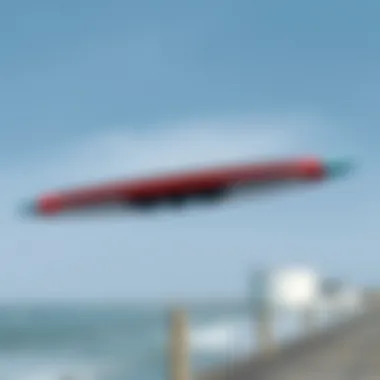
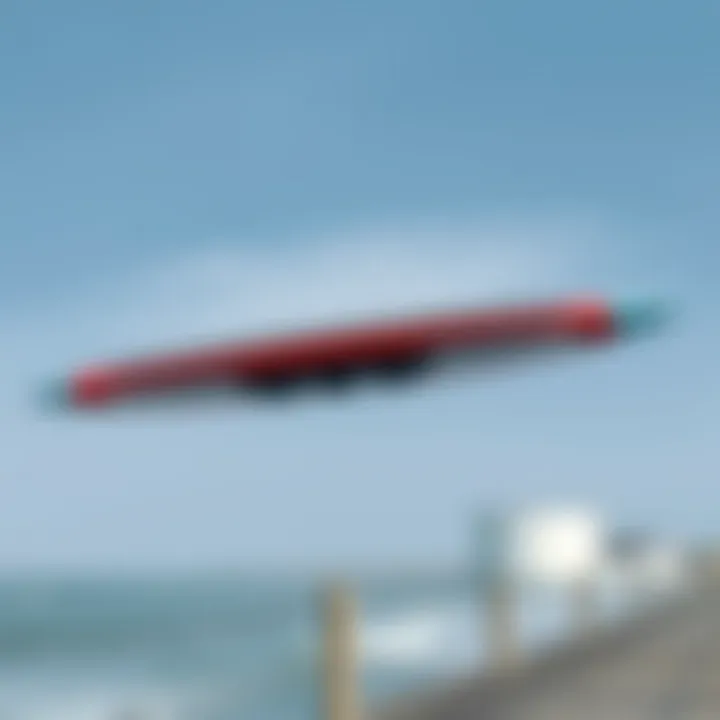
Challenges in Electric Hydro Board Development
The development of electric hydro boards is not without its hurdles. While these boards represent a major step forward in water sports innovation, they come with their own set of challenges. These obstacles must be addressed to enhance performance, ensure user safety, and make the technology accessible to a broader audience. By examining these challenges, we gain insights into where the industry stands and where it must focus its efforts for future developments.
Cost Implications
One of the most glaring difficulties with electric hydro boards is the cost. The price tag associated with these boards can be a real barrier to entry for many potential users. To get a decent electric hydro board, an enthusiast might find themselves shelling out upwards of several thousand dollars. This high cost can be attributed to multiple factors:
- Advanced Materials: The construction of these boards often requires lightweight yet strong materials such as carbon fiber and specialized plastics, which can substantially hike production expenses.
- Battery and Motor Technology: The inclusion of cutting-edge battery solutions, like lithium-ion technology, adds to the overall cost. These batteries need to be powerful and lightweight to ensure optimal performance on the water.
- Research and Development: Companies invest a lot of resources into perfecting the technology. The research phase, testing, and feature enhancements contribute to the final price of the product.
While manufacturers strive to lower costs, the luxury nature of the electric hydro board remains, making it primarily accessible to a niche market of affluent enthusiasts.
Technical Limitations
Another significant challenge is faced in the realm of technical limitations. The electric hydro board, despite its sleek design and innovative features, still grapples with various performance constraints:
- Battery Life: Depending on the riding style, the battery can last anywhere from 30 minutes to a couple of hours. Users engaged in aggressive maneuvers might find themselves running low on power quicker than expected.
- Weight Handling: Heavy riders or additional gear can drastically affect how the board performs. Manufacturers must strike a delicate balance between sturdiness and weight, making it a tricky engineering puzzle.
- Control Systems: Navigating an electric hydro board can be a fine art. Current tech sometimes struggles to provide a seamless and responsive riding experience, with some users reporting lag during rapid maneuvers.
These technical hurdles necessitate ongoing innovation and testing, as developers aim to boost reliability without sacrificing performance.
Safety Concerns
Safety remains a pressing concern within the electric hydro board arena. As exhilarating as these boards can be, they also present risks that are particularly notable for both novice and seasoned riders:
- Speed Control: The thrill of zipping across the water can lead to a false sense of security. Some riders might find them difficult to control at high speeds, potentially leading to accidents. Proper understanding and communication of speed limits is key.
- Environmental Hazard Awareness: Riders must be made aware of their surroundings. Lakes, rivers, or coastal areas might harbor submerged obstacles or other hazards that could pose threats to the rider.
- User Training: Ensuring that users understand how to operate their boards safely should be a priority. Simple lessons that cover everything from basic handling to emergency stop techniques can reduce accidents.
> "As exciting as it is to ride an electric hydro board, neglecting safety protocols can quickly turn fun into disaster."
Addressing these safety concerns requires proper education, robust design elements, and ongoing dialogue within the community to foster responsible riding practices.
Market Trends and Consumer Interest
In the realm of water sports, the electric hydro board is not just another gadget; it reflects the pulse of contemporary water-based activities. Understanding the market trends and consumer interest surrounding these boards is crucial for manufacturers, retailers, and riders alike. These factors not only influence product development but also shape the community of enthusiasts who embrace this cutting-edge technology. Diving into this topic reveals key elements that highlight the ongoing transformation in the water sports landscape.
Current Market Dynamics
The electric hydro board industry exhibits a distinctive growth trajectory, driven by a blend of innovation, consumer preferences, and sustainability consciousness. A few notable aspects of the current market dynamics include:
- Technology Advancements: With rapid progress in battery efficiency and propulsion systems, companies are now producing more reliable and longer-lasting electric hydro boards that meets the demands of adventurous users.
- Growing Popularity: There's a palpable buzz around these boards, often seen at beaches and lakes. Riders appreciate the ease of use and the exhilarating feeling they bring, making them increasingly popular among water sport enthusiasts.
- Diverse Consumer Base: As manufacturers expand their offerings, the demographic of consumers using electric hydro boards has widened. It includes not only seasoned kiteboarders but also families and recreational water sports fans looking for a new thrill.
"The electric hydro board is becoming a game changer, not just for kiteboarding but for the entire water sports community."
Additionally, grass-roots marketing efforts through social media platforms like Instagram and Reddit have played a vital role in boosting visibility and interest. Riders sharing their experiences create a sense of community and drive curiosity among potential consumers.
Consumer Feedback
Consumer feedback serves as a goldmine of insight within this dynamic market. The voices of those who voyage on electric hydro boards often provide critical information on what works well and what leaves room for improvement. Here are some key takeaways from consumer reviews and discussions:
- Performance and Enjoyment: Users frequently express satisfaction with the performance of electric hydro boards, reporting high levels of enjoyment due to features like speed, maneuverability, and the unique thrill of riding above water.
- Durability and Maintenance: Some consumers raise concerns about the longevity of certain models, leading to discussions about maintenance practices and potential upgrades. Riders want boards that can withstand frequent use without constant repairs.
- Affordability: Price remains a hot topic. While many recognize the value of advanced technology, some consumers feel that prices can be prohibitive. Feedback highlights the need for companies to consider a range of price points to cater to varying budgets.
Best Practices for Using Electric Hydro Boards


Using an electric hydro board can elevate your experience on the water, but proper usage ensures you get the most out of this exciting technology. Knowing the best practices can make all the difference — not just for performance, but also for safety and longevity of your equipment. Here’s a thorough exploration of the essential elements, benefits, and considerations you should have in mind while using electric hydro boards.
Preparation and Setup
Before embarking on your electric hydro boarding adventure, how you prepare is crucial. First off, always ensure that the board is fully charged and check the battery indicators. After all, being caught out on the water with a dead battery is akin to running out of gas on a long drive.
Moreover, inspect all major components:
- The propeller should spin freely without obstruction.
- Check the board for any damage or wear, particularly the hull.
- Make sure the connections for the battery and motor are secure.
Also, familiarize yourself with the control system. Get a good grip on the remote or any control unit you will be using because, let’s face it, you wouldn’t want to be fumbling with buttons when hitting those waves!
Offering a good starting point, beneficial tips can get you smoothly afloat:
- Find a calm spot: Look for a flat, unobstructed area where you can practice without waves throwing you off account. A gentle lake or lagoon may just do the trick.
- Wear appropriate safety gear: Helmet, life vest, and even impact shorts can make your ride safer.
Riding Techniques
Once you're set up and in the water, the riding technique becomes key. Stand with your feet shoulder-width apart, keeping a slightly bent knee. This position acts like a spring, absorbing shocks and helping with balance.
As for the controls, a gentle approach is advisable. Yanking the throttle won’t benefit you; smooth, controlled acceleration will permit better balance. Think of it like learning to ride a bicycle: the more gradually you learn how to steer, the easier it is to navigate.
Here are some techniques to bear in mind while mastering your riding:
- Shift your weight: Lean slightly forward to gain speed and slight back to decelerate. Subtle shifts work wonders in controlling direction too.
- Look ahead: Your body naturally follows your gaze, so keep your head up and look toward where you want to go, rather than staring at the water beneath your feet.
- Practice falling: Not every ride will be smooth. Practicing how to fall safely can help limit injuries — learn to roll as you hit the water instead of just plunging straight in, if things go south.
Maintenance and Care
To keep your electric hydro board operating smoothly, regular maintenance is a must. Treat it like your prized possession rather than an afterthought. Proper upkeep prevents issues down the line and prolongs the lifespan of your gear.
- Clean the board: After every session, rinse your electric hydro board with fresh water to remove salt and debris, which can corrode parts.
- Inspect seals and joints: Regularly check the water-tight seals and make sure all joints are tight. Keeping water out of sensitive components is essential.
- Battery care: Follow the manufacturer's guidelines for charging cycles. Avoid draining the battery completely; lithium batteries function best when kept between 20-80% charge.
- Store properly: When not in use, keep the board in a cool, dry place. Extreme heat might damage the battery and electronics.
"Regular maintenance is like an investment in tomorrow. Take care of your board today, and it will serve you well tomorrow."
In summary, immersing yourself in these best practices can bolster your experience on an electric hydro board. Preparation, riding techniques, and diligent maintenance all play integral roles in transforming a standard ride into an unforgettable one.
The Future of Electric Hydro Boards in Kiteboarding
The horizon for electric hydro boards looks bright, a promising landscape layered with innovation and opportunity in the world of kiteboarding. As this technology burgeons, kiteboarding enthusiasts can expect significant enhancements in both their experience on the water and the sustainability of the sport itself. The future here is not just about excitement; it's also about practical implications. With advances that prioritize environmental responsibility alongside user experience, the electric hydro board is poised to reshape our aquatic adventures.
Innovative Trends on the Horizon
Change is in the air, specifically the sort that whispers about integration of smart technology and eco-friendly materials in electric hydro boards. Here's what stands out:
- Smart Technology Integration: New models are beginning to incorporate sensors that monitor battery levels, ocean conditions, and the rider�’s performance metrics. This is like having a coach right there with you on the water, giving insights that can enhance skill development.
- Eco-Conscious Production: As environmental concerns rise, manufacturers are leaning towards sustainable materials. Think recycled plastics and bio-based composites. Such materials not only reduce the carbon footprint but also appeal to consumers who value sustainability.
- Enhanced Safety Features: New developments in hydrodynamics are creating boards that are not only more stable but also easier to maneuver. Features like auto-positioning and system failsafe modes further contribute to rider safety, crucial for both novices and seasoned kiteboarders.
These innovative trends indicate a shift that caters to both performance and responsibility, suggesting that kiteboarding can evolve to be a thrilling adventure while promoting an ecological conscience.
Integration with Kiteboarding Technology
The synergy between electric hydro boards and kiteboarding technology is becoming increasingly evident. This bond is crucial for both recreational pleasure and competitive engagement. Some key points of integration include:
- Advanced Propulsion Systems: The propulsion technology used in electric hydro boards is directly influencing kiteboarding. Riders will experience smoother rides with optimized speed control, improving the agility and responsiveness of the board, making tricks and navigation much easier.
- Unified Systems for Performance Tracking: Imagine real-time tracking of your jumps or your distance traveled, communicated between your board and your kite. Such integration could lead to new competitive formats and training methodologies, pushing the limits of what's possible in kiteboarding.
- Shared Resources and Knowledge: As communities share insights about electric hydro boards and their use in kiteboarding, it creates a learning hub for enthusiasts. Online forums like Reddit foster conversations that lead to collective understanding about best practices or maintenance tips, thereby cultivating a vibrant community around the sport.
The experience of kiteboarding is set to get richer and more intricate, marrying tradition with modern tech in a way that enhances not only the thrill but also the learning curve for newcomers.
"The electrification of kiteboarding is not just a trend; it's a transformative movement that promises a new chapter for water sports enthusiasts."
As we look toward the future, we see that the electric hydro board is more than just equipment—it's a harbinger of a new age in kiteboarding. Individuals from all backgrounds can look forward to a sport that embodies innovation while remaining deeply attuned to nature.


